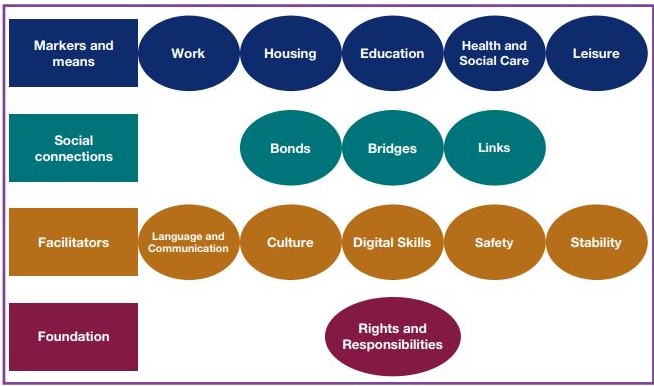
By Professor Jenny Phillimore, Department of Social Policy, Sociology & Criminology
School of Social Policy, University of Birmingham
2017 saw the highest number of displaced people ever at 68.5m (UNHCR 2018) – therefore it is no surprise that interest in refugee integration continues to increase. The arrival of refugees in Europe in 2015 generated much debate among the public and policymakers, whilst the media played a role in exacerbating concerns by phrasing their arrival as a ‘refugee crisis’. This so-called ‘crisis’ made the resettling and integrating of forced migrants a preoccupation, with the emphasis very much on the responsibility of refugees to integrate themselves into major societies.
However, as the EU states in its Common Basic Principle for Integration, integration is the responsibility of all stakeholders. Yet despite this, designing good integration policies and interventions that can support integration in all aspects, and how to evaluate the effectiveness of those interventions and policy, continues to be a challenge for stakeholders.
In 2004, Alister Ager and Alison Strang produced a set of refugee integration indicators for the UK’s Home Office in an early attempt to resolve some of these challenges. Since then, the original report and associated journal article have been cited over 1,500 times, with the indicators being used by academics, policymakers and practitioners on a national and global scale.
With the advent of the ‘crisis’, the need for a renewed set of indicators became apparent. As an academic with 20 years’ experience studying refugee integration, I was fortunate to be invited, along with Alison Strang and Linda Morrice, to participate in the renewal of the indicators. Having used the indicators to help structure an evaluation of the European Refugee Fund and to analyse the Survey of New Refugees amongst other things, I was very familiar with the indicators, both – their strengths and shortcomings.
For me, there were particular concerns about the lack of attention to multi-dimensional integration: the absence of focus on the role of the state, NGOs and the wider population. However, it was also evident that there were gaps in the indicators with little consideration of IT, which has become increasingly important in everyday life to access work and welfare but also to build and maintain social connections. In addition, no attention was given to social care, self-employment or the importance of sharing knowledge about institutional and wider cultures.

Two meetings turned into two years of development and consultation, led by the Home Office Migration and Border Analysis Unit with the involvement of most Government departments: the UK’s devolved authorities, NGOs and refugees across the UK, and an extended body of academics and practitioners. The new indicators are informed by a large body of research on the topic, and not only cover more ground than the 2004 indicators, but they take on board a number of principles including the importance of supporting refugees to develop bonding networks, which often tend to be viewed by policymakers as problematic ‘self-segregation’.
We were able to make this change due to our previous work on an analysis of the UK’s Survey of New Refugees (SNR) that such networks benefit refugee integration. The new indicators draw into focus the importance of recording and addressing racism against refugees – a factor we found to be anti-integrative in our SNR analysis. They also note the importance of measuring and encouraging welcoming behaviour and shift away from language such as ‘meaningful mixing’ and ‘British values’ which have tended to feature heavily in policy materials previously. The move away from placing all emphasis on refugees, and changes in the role of host communities and state, represent a significant step forward in changing attitudes about integration.
The change of indicators and language are not the only innovations. As the project proceeded and consultation was underway, the need for other materials became apparent. The Indicators of Integration (IOI) now come with a set of local and national guidelines, setting out the kinds of initiatives that can be introduced to help deliver positive outcomes for all. We added an interactive toolkit which contains all instruments that the Home Office could find in UK and European Social Surveys linked to individual indicators.
The toolkit was followed by a ‘What Works’ document wherein we collated all the information we could find on good practice in integration from the UK and Europe, including the outcomes of European Refugee Fund evaluations and our SNR work. Finally, we added a ‘Theory of Change’ document that is aimed at helping users to plan and evaluate integrative actions relating to their individual goals.
Whilst there is room for growth and development, the new suite of integration documents represents the most comprehensive materials available to support users of all kinds. If the IOI are as widely used as the 2004 version, then they have the potential to reframe thinking globally.
References:
1. Cheung, S.Y. and Phillimore, J., 2014. Refugees, social capital, and labour market integration in the UK. Sociology, 48(3), pp.518-536. https://journals.sagepub.com/doi/abs/10.1177/0038038513491467
2. Cheung, S.Y. and Phillimore, J., 2017. Gender and refugee integration: a quantitative analysis of integration and social policy outcomes. Journal of Social Policy, 46(2), pp.211-230
https://www.cambridge.org/core/journals/journal-of-social-policy/article/gender-and-refugee-integration-a-quantitative-analysis-of-integration-and-social-policy-outcomes/436AACF96C756372E784AD245FFE2E61
3. Phillimore, J., 2012. Implementing integration in the UK: lessons for integration theory, policy and practice. Policy & Politics, 40(4), pp.525-545. https://www.ingentaconnect.com/content/tpp/pap/2012/00000040/00000004/art00005
